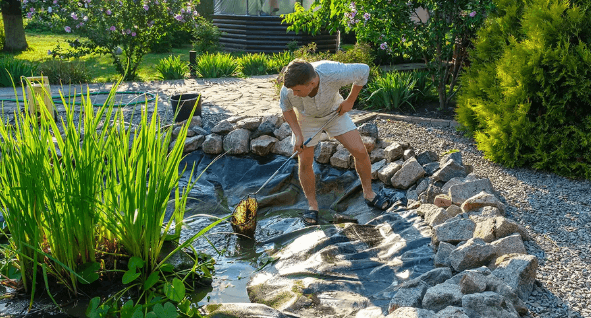Proven Strategies for a Cleaner Pond That Looks and Functions Beautifully

A pond can transform your backyard into a peaceful oasis—until it turns murky, smelly, or overwhelmed by algae. If you’re tired of dealing with green water, debris buildup, or foul odors, you’re not alone. Keeping a cleaner pond isn’t just about appearance—it’s crucial for supporting healthy fish, thriving plants, and a balanced ecosystem. This article dives deep into the most effective techniques and tools to maintain a naturally clean, low-maintenance pond all year round.
Why Pond Cleanliness Matters Beyond Aesthetics
A clean pond offers more than just visual appeal. It supports the health of everything living within it—fish, plants, snails, and beneficial bacteria. Poor water conditions can cause:
- Fish stress and disease
- Algae blooms
- Odors and discoloration
- Invasive insect breeding (like mosquitoes)
Ponds left unmanaged can even damage nearby landscaping due to overflow or excessive nutrient buildup.
The Natural Balance of a Healthy Pond
The key to a cleaner pond lies in achieving ecological balance—where natural elements work together to keep the water clear and stable. This includes:
- Oxygen levels
- Beneficial bacteria
- Plant cover
- Proper circulation
When these factors are in harmony, your pond can remain clean with minimal effort.
Step-by-Step Guide to Achieving a Cleaner Pond
1. Start with Regular Skimming and Debris Removal
Remove leaves, twigs, and uneaten fish food regularly using a pond net or surface skimmer. Organic waste breaks down over time and increases nutrient levels that feed algae.
Tip: Install a floating or mechanical skimmer to automate this process in larger ponds.
2. Use a Quality Filtration System
A proper filtration system removes physical debris and supports biological waste breakdown. For most ponds, combining mechanical, biological, and optionally UV filtration provides the best results.
- Mechanical filters trap solid particles
- Biological filters house beneficial bacteria
- UV clarifiers eliminate microscopic algae
Pro Tip: Oversize your filter slightly to handle peak conditions like hot weather or heavy fish load.
3. Introduce Beneficial Bacteria
Natural bacteria supplements are available in liquid or pellet form. These organisms consume sludge, fish waste, and excess nutrients that lead to cloudy water and foul smells.
When to add: Early spring, during warm weather, or after cleaning.
4. Control Algae Naturally
Algae thrives on excess nutrients and sunlight. To minimize its presence:
- Add floating plants like water lilies or hyacinths to shade the pond
- Use barley straw extract to naturally inhibit algae growth
- Limit fertilizer use around the pond’s edge
Avoid chemical algaecides unless absolutely necessary—they can harm fish and beneficial microbes.
5. Perform Seasonal Cleanouts
In spring and fall, drain a portion of the pond (about 25–50%) and remove built-up sludge from the bottom. Replace the water using a dechlorinated source or let tap water sit overnight.
Don’t fully drain the pond unless absolutely necessary, as it can disturb established biological balance.
6. Add the Right Aquatic Plants
Aquatic vegetation plays a powerful role in keeping water clean:
- Submerged plants (like hornwort) oxygenate and consume nutrients
- Marginal plants (like iris or pickerel rush) filter runoff and excess nutrients
- Floating plants (like duckweed or water lettuce) block sunlight and reduce algae
A mix of these plant types helps regulate the ecosystem naturally.
7. Aerate the Pond for Oxygen and Circulation
Stagnant water quickly turns dirty and foul. Adding an air pump, fountain, or waterfall increases oxygen levels and circulation, making the water less hospitable to harmful bacteria and mosquitoes.
Bonus: Proper aeration supports beneficial bacteria and helps fish thrive.
8. Maintain Healthy Fish Habits
Fish are beautiful to watch, but overstocking or overfeeding can make pond care harder.
Clean fishkeeping tips:
- Feed only what fish can consume in 2–3 minutes
- Avoid feeding in very cold or hot weather
- Stock 1–2 inches of fish per 10 gallons of water for small ponds
Fish waste is one of the biggest contributors to poor water quality, so keeping balance is crucial.
9. Test Your Water Monthly
A test kit helps monitor:
- Ammonia
- Nitrites
- Nitrates
- pH
- Water hardness
Safe levels vary, but regular testing lets you take action early before problems become visible.
10. Avoid Runoff and Contaminants
If your pond is near a lawn or garden, rainwater can wash in fertilizers, pesticides, and other pollutants. This spikes nutrient levels and creates algae blooms.
Fixes:
- Add a buffer zone of gravel or plants around the edge
- Use rain gardens or downspout redirection
- Keep lawn care products away from the pond border
Tools and Products That Help Keep a Cleaner Pond
Here are a few tools worth investing in for long-term clarity:
- Pond Vacuum: For removing settled muck and debris
- Floating Skimmer: For removing surface leaves automatically
- UV Sterilizer: Best for green water control
- Barley Straw Extract: Natural algae deterrent
- Bacterial Additives: Supports biofiltration
- Dechlorinator: For safe water changes
How Often Should You Clean Your Pond?
Here’s a general seasonal guide:
- Spring: Partial cleanout, restart filter, plant trimming, bacteria treatment
- Summer: Weekly skimming, topping off water, algae control
- Fall: Netting for leaf control, partial cleanout
- Winter: Minimal intervention, maintain aeration if needed
Small ponds may need more frequent cleaning. Larger ponds with a balanced ecosystem often require less maintenance.
Final Thoughts: Your Path to a Cleaner, Healthier Pond
Achieving a cleaner pond isn’t about one quick fix—it’s about adopting consistent habits and understanding the natural processes at play. By combining proper filtration, balanced aquatic life, and mindful maintenance, you can enjoy crystal-clear water that enhances your garden and supports a vibrant ecosystem.
Remember, every pond is unique. Pay attention to how yours responds to changes and adjust your routine as needed. The reward? A serene, healthy water feature that stays beautiful without constant work.
FAQs
How long does it take to clean a dirty pond?
If it’s a deep clean, allow 1–2 days, including draining, scrubbing, and water cycling. Minor maintenance can be done in under an hour.
Do I need to drain my pond to clean it?
No. Partial water changes and using a pond vacuum often suffice. Full draining can disrupt the ecosystem.
Is algae bad for ponds?
Not always—some algae is natural. Excessive algae, however, clouds the water and disrupts oxygen balance.
Can I keep my pond clean without a filter?
It’s possible in a naturally balanced pond with enough plants and low fish load, but a filter makes maintenance much easier and more consistent.
How often should I change pond water?
Change 10–25% of the water every 1–2 weeks, depending on pond size and fish stock.



